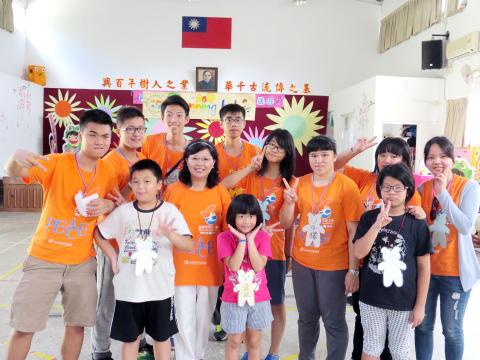Students from Songshan Senior High School in Taipei organized a service team to go to Xinghua Elementary School in New Taipei City’s Sanjhih District and hold a four-day, three-night “Running Kids educational and recreational camp.” The teacher in charge, Kuo Ching-ching, says that this camp was planned around the themes of science and environmental protection, in the hope of using interesting science games and DIY lessons to let children from a school in an outlying area gain an easy understanding of scientific knowledge. With a smile, Kuo says that all the lessons were planned by the students, who did everything by themselves, from the initial planning and conception through to surveying the location and making improvements.
After getting confirmation of which colleges have accepted them in May and June, the 29 students who took part in this project planned the activities on their own initiative, hoping to use experiments and playacting as ways of interacting with the children, so as to let them easily get an understanding of scientific knowledge and the importance of environmental protection.
The scientific experiments were well integrated with everyday life. For example, one involved drooping a string onto an ice cube and then sprinkling it with salt. Because the salt causes a fast-freezing effect when it comes in contact with the ice cube, the ice cube can be lifted up with the string. The children all thought this was amazing. The service team also blended environmental protection ideas into a play, which was entitled “The 3R Kids” — the three Rs being reduce, reuse and recycle. In the course of acting in the play, as well as getting an understanding of environmental protection concepts, the children also got to learn some English.

Photo courtesy of Taipei Municipal Songshan Senior High School
照片由松山高中提供
Service team organizer Shen Yun-i has been accepted to study in the Department of Nursing at National Cheng Kung University. She says that everyone got absorbed with great enthusiasm and went from being strangers to having an unspoken understanding. “We learned a lot of things that we never learned in class. It was really great!” she says.
(Liberty Times, translated by Julian Clegg)
台北市松山高中學生組服務隊,到新北市三芝區興華國小進行四天三夜的「Running Kids育樂營」,帶隊老師郭靜靜表示,這次營隊以科學、環保為主軸設計課程,希望透過有趣的科學遊戲、DIY課程,讓偏遠學校的孩子們能輕易理解科學知識。她笑說,所有的課程全部由學生規劃,從企劃、構思、場勘、改進都一手包辦。
參與這次計畫的廿九名學生,在五、六月確定錄取學校後,主動規劃活動,希望藉由做實驗、演戲和小朋友互動,讓小朋友輕易理解科學知識以及環保的重要。
科學實驗相當生活化,像是在冰塊上擺一條線,之後再撒鹽,因鹽巴遇到冰塊會有急速冷凍效果,一條線就可把冰塊拉起來,每個小朋友都覺得好神奇!服務隊也把環保觀念融入戲劇,劇目是「3R寶寶」,分別為reduce、reuse、recycle,演戲過程中,小朋友除了解環保概念,還能學英文。
服務隊總召沈芸伊錄取成大護理系,她表示,看到大家熱情投入,從彼此陌生到有默契,「我們學到很多課堂上學不到的東西,真的很棒!」
(自由時報記者梁珮綺)

In an effort to fight phone scams, British mobile phone company O2 has introduced Daisy, an AI designed to engage phone con artists in time-wasting conversations. Daisy is portrayed as a kindly British granny, exploiting scammers’ tendency to target the elderly. Her voice, based on a real grandmother’s for authenticity, adds to her credibility in the role. “O2” has distributed several dedicated phone numbers online to direct scammers to Daisy instead of actual customers. When Daisy receives a call, she translates the scammers’ spoken words into text and then responds to them accordingly through a text-to-speech system. Remarkably, Daisy

Bilingual Story is a fictionalized account. 雙語故事部分內容純屬虛構。 Emma had reviewed 41 resumes that morning. While the ATS screened out 288 unqualified, she screened for AI slop. She could spot it a mile away. She muttered AI buzzwords like curses under her breath. “Team player.” “Results-driven.” “Stakeholder alignment.” “Leveraging core competencies.” Each resume reeked of AI modeling: a cemetery of cliches, tombstones of personality. AI wasn’t just changing hiring. It was draining the humanity from it. Then she found it: a plain PDF cover letter. No template. No design flourishes. The first line read: “I once tried to automate my

Every May 1, Hawaii comes alive with Lei Day, a festival celebrating the rich culture and spirit of the islands. Initiated in 1927 by the poet Don Blanding, Lei Day began as a tribute to the Hawaiian custom of making and wearing leis. The idea was quickly adopted and officially recognized as a holiday in 1929, and leis have since become a symbol of local pride and cultural preservation. In Hawaiian culture, leis are more than decorative garlands made from flowers, shells or feathers. For Hawaiians, giving a lei is as natural as saying “aloha.” It shows love and

1. 他走出門,左右看一下,就過了馬路。 ˇ He walked outside, looked left and right, and crossed the road. χ He walked outside and looked left and right, crossed the road. 註︰並列連接詞 and 在這句中連接三個述語。一般的結構是 x, y, and z。x and y and z 是加強語氣的結構,x and y, z 則不可以。 2. 他們知道自己的弱點以及如何趕上其他競爭者。 ˇ They saw where their weak points lay and how they could catch up with the other competitors. χ They saw where their weak points lay and how to catch up with the other competitors. 註:and 一般連接同等成分,結構相等的單詞、片語或子句。誤句中 and 的前面是子句,後面是不定詞片語,不能用 and 連接,必須把不定詞片語改為子句,and 前後的結構才相等。 3. 她坐上計程車,直接到機場。 ˇ She took a cab, which took her straight to the airport. ˇ She took a cab and it took her straight